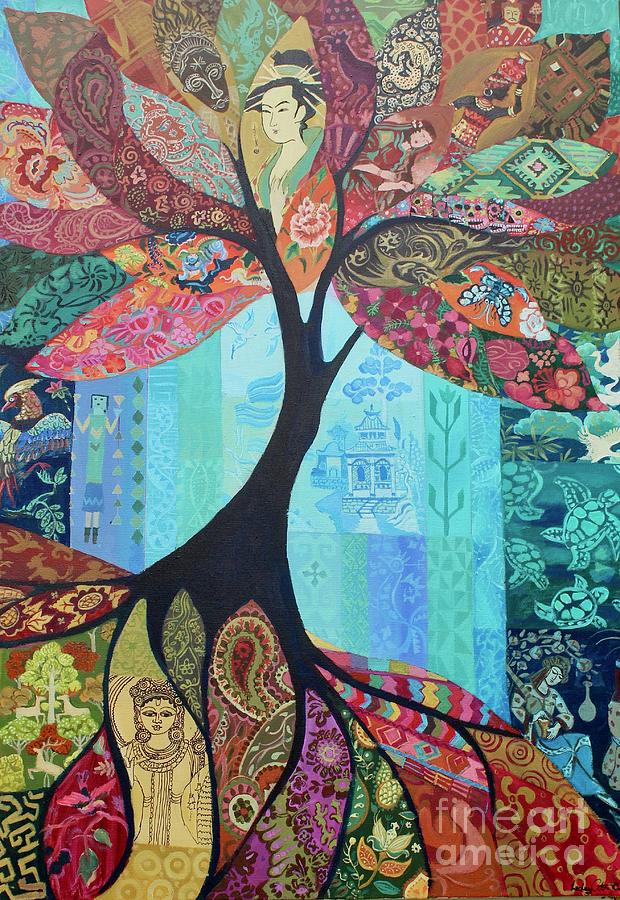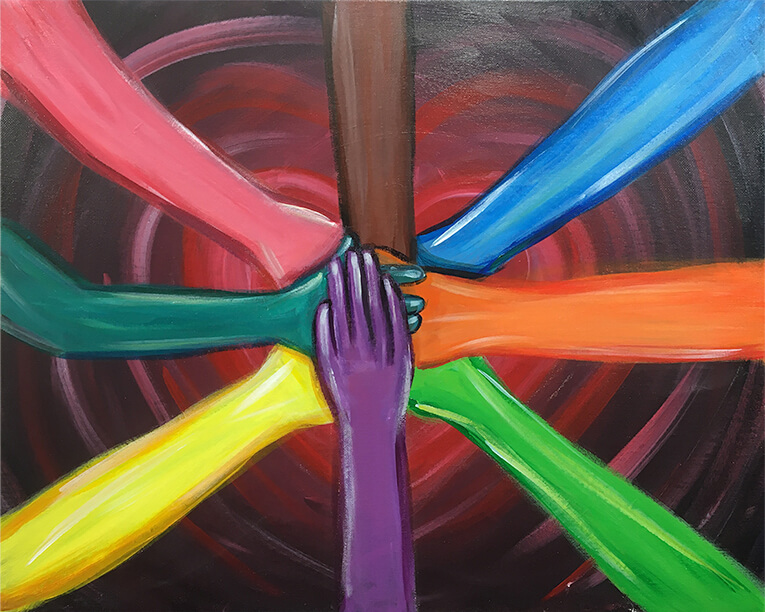
Unity (also called harmony) is an important principle of design that gives the artwork a sense of cohesion or coherence. It is the wholeness or completeness of a picture. Unity and harmony in art are used by artists to tie a composition together and help the composition make sense as a whole piece of art.
Every marriage starts out as a blank canvas and every day is a splash of color. I would love to Illustrate that very idea, during a wedding ceremony. And all that would be needed, is a blank canvas, an easel ( with a protective tray, placed on a protective sheet), a collection of small jelly jars filled with vibrant colors of paint and a willing couple. The couple would (very carefully) pour the jars of paint down the front of their canvas to symbolize the creating of a life together. The blank canvas represents, the day of the wedding, and a new beginning. The paint colors signify the experiences that lie ahead. Each color a moment to be had. Colors of joys and sorrows, blessings and heartache. The colors are the couples milestones, their celebrations, tribulations, passions and dreams. They are the moments that become the days that make-up the years. The painted canvas will be the couples life (and life's art). It will be exactly what the two of them make it. There will be places on the canvas when the colors blend and mix, flowing together, creating a new color of experiences shared. There will be places when the colors stay separate and stand out alone and independent... yet, still a compliment to the bold color by it's side. And there may be places of contrast. Parts of the canvas that look dark or messy and not at all to the couples liking. While another spot remains blank and bare. However, when you step back and look at the canvas in it's entirety, you will see that it clearly is 'An Original Masterpiece' unlike anything you've ever seen before. Each color, contrast, shadow, blend as unique and beautiful as each couple. 2/14/2013 10:25:20 am What a beautiful idea. It would be especially lovely if it was a wedding for a blended family, and all the children and bride and groom created a painting together. 7/19/2016 09:47:50 am I love this!! I am doing this for an upcoming wedding but there are children involved, ideas for that wording would be appreciated. 12/3/2020 01:35:21 am Appreeciate your blog post Leave a Reply. |
What is emphasis? What is subordination? And how do they relate to each other and the composition?
- Commercial Painting & Wallcovering. Recent Projects. To Contact us: Laura Buler, President/General Manager. Unity Painting, LLC.
- Unity is created by the repetition of the flags and the people, and the arrangement on the canvas, with all elements of the composition facing inward from the edges of the canvas. Variety is provided by variations in the sizes and position of the flags and people.
Emphasisis defined as an area or object within the artwork that draws attention and becomes a focal point.
Subordination is defined as minimizing or toning down other compositional elements in order to bring attention to the focal point.
Focal point refers to an area in the composition that has the most significance, an area that the artist wants to draw attention to as the most important aspect.
In the example below, it is very clear that the emphasis is on the red circle. It is the largest object in the composition. Conversely, although there are many gray circles, they are small in size, very muted in color, and blend in rather than stand out from the background.
The large circle is an extremely intense (pure) color which contrasts dramatically with the muted gray circles and background. The large, intensely red circle is bordered with an intense green that is a complementary color to the red, and equal in its intensity. Complementary colors (across from each other on the color wheel) with a high degree of intensity draw the most attention.
Therefore, the red circle is the focal point of the composition.
Examples of emphasis, and subordination in artwork
Emphasis using color
Richard Anuszkiewicz Deep Magenta Square
image source http://www.newworldencyclopedia.org/entry/Op_art
This is an example of op art, a movement that became popular in the 1960's. Op art plays with visual perception and often, color combinations or patterns that can be very difficult to look at and focus on. It is obvious that the magenta square is emphasized in the composition, and is definitely the focal point. Although the colors in the rest of the composition are fairly intense, they are much less intense than the magenta circle. They are also smaller areas than the square, thin lines rather than a large square that dominates the composition. Notice how the combination of colors and lines play with depth of space, and receding and advancing areas.
Emphasis using value (light and dark)
Kathe Kollwitz Battlefield 1907
etching mounted on wove paper
Private Collection
image source http://www.mystudios.com/women/klmno/kollwitz_battlefield.html
This is a poignant portrayal of a mother searching for her dead son after a battle. The light she is carrying casts a strong light upon the dead soldier, working in the same manner as a spotlight on stage would. Her hand reaching out and touching the soldier is also emphasized. In fact, the touch of the strong hand on the chin of the soldier--whose head falls back limply--is the focal point of the image. It is as if by touching the soldier she might bring him back to life.
In contrast, the figure of the mother is bent over, and the darkest area of the composition. Her hunched, dark shape contrasts starkly with the soldier's tilted back, brightly lit head.The mother's figure is the second most important aspect of the composition. The rest of the composition consists of indistinct areas of varying shades of gray. The only other reference to a battlefield is the soldier's head next to the mother's son. This keeps us from being distracted by other details or areas in the composition and focused on the mother's hand and the son's face.

Emphasis using complementary colors and atmospheric perspective
Paul SignacEvening Calm, Concarneau, Opus 220 (Allegro Maestoso) 1891
Oil on canvas 25 1/2 x 32in. (64.8 x 81.3cm); Framed: 40 1/4 x 34 in. (102.2 x 86.4cm)
Metropolitan Musem of Art, New York
Robert Lehman Collection, 1975
The emphasis here is on the rocky shoreline on the left lower part of the painting. Using the principles of atmospheric perspective, the foreground is more intense in color and more sharply delineated. The background is increasingly muted as it recedes in space, and the colors tend to blend together.The use of complementary colors--violet and yellow--accentuates this effect, because complementary colors draw attention, and the more intense they are, the more they attract attention.
Signac used a system of color harmony and precisely applied strokes of color. Following and adapting the technique of Georges Seurat, he placed separate hues of color next to each otrher, without mixing them. The viewer 'mixes' the colors with their eyes. Standing up close to the painting, the viewer sees only dots or strokes of color. Moving back, the subject matter ofthe image comes into 'focus'. This technique creates a shimmering effect of light.
Emphasis using intensity of light
Joseph Mallord William Turner Yacht Approaching the Coast
oil on canvas
Unity Paintings
Image courtsy of wiliam-turner.org
Famous Artwork That Shows Unity
Turner uses rays of light from a sunset on the water, with increasing intensity toward the center of the painting. Subtle variations in color create 'lines' that all lead to the center of the painting. The golden shimmering light on the water leads the eye directly to the orange glow of the sunset. The yacht approaching the coast can be seen as heading toward the sunset instead of the coast, with its sails pointing toward the sunset.
Emphasis using the center of the compositon and one spot of bright color
Unity Paint Ceremony

Akseli Gallen-Kallela The Great Black Woodpecker, 1892-94
Oil on canvas, 145 x 90 cm
Private Collection
image source: artsmia.org (Minneapolis Institute of Arts)
Unity Painting Examples
The leafless limbs of the dead trees and branches create lines that all point toward the woodpecker. The tree limbs are larger and lighter in color than the surrounding trees, creating a stark contrast which emphasizes their 'path' to the woodpecker. The tallest ree disappears into the sky, but its branches lead to the river, which in turn leads to the bleached branches of the dead tree in the foreground.
The woodpecker, unlike anything else in the painting, is portrayed using bold and intense hues of black and red. It appears to be the only animated form in the painting, as if all of the surrounding landscape has paused for a moment as a tribute to the woodpecker.

